
Blade 400 RC Helicopter
The Blade 400 RC helicopter is one of the best values on the market for people who are just starting out in this fun hobby or perhaps just getting back into RC helicopters after many years and are intimidated by how much the hobby has changed over the past decade with advancements such as electric flight, computerized radios, heading lock gyros, and cyclic collective pitch mixing to name a few.I was so impressed after flying the Blade; I purchased one to share the experience. I was looking for the best hobby grade single rotor RC helicopter to recommend for first timers on a fairly tight budget to start with.
A good quality heli set up that they could grow with and one that would provide years of flying fun. As it turned out, the Blade 400 was so much more then that. It really is such a good RC helicopter for so many people – yes I too am hooked on electric flight now thanks to this little rascal and it was the perfect stepping stone to get into larger electric birds such a the T-Rex 600ESP for example.
There are several 400 size electric helis that I consider to be the best on the market right now to learn and grow on. This means everything from your first ground hover exercises up to 3D if you take it that far. Value and quality were just as important if not more so. Remember value is not the lowest up front cost, but the long term costs associated with operating and maintaining the model.
The Align T-Rex 450 Pro Super Combo was certainly high on the list; in fact, if I was purchasing a 400 series heli just for me, the T-Rex 450 would be the hands down winner. I also was looking at Miniature Aircrafts Furion 450, but realized that was a little over the top for the beginner – performance and price wise. It is an amazing bird however! Other good 400's on the market that deserve a thumbs up include Thunder Tiger's Mini Titan E325, and Beam's 450 E4.
So why did the Blade 400 win out in the end? Three short words - “The Complete Package”.
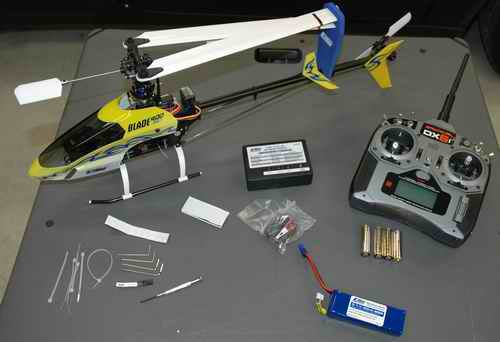
This pretty much pushes the Blade 400 to the top in terms of real value and bang for the buck. You know I am one for parts availability, and E-Flite’s parts support, just like Align's is simply outstanding – anywhere in the world. Parts support is important, but let's talk about about the crown jewel that comes with this bird - the Spektrum DX6i Radio.
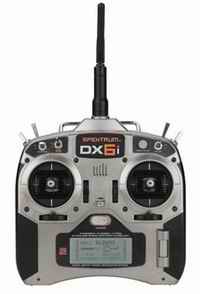 I really like this radio.
I really like this radio. The one touch scroll button is so much better than the up, down, and enter buttons on most other computerized radios. The DX6i also displays pitch and throttle curves graphically, the Futaba 6EX (Futaba's entry level computerized radio) doesn’t. If you read my RC Helicopter Radio page, you know why this is so important and why having a computerized programmable radio is also important.
Once you get into quality collective pitch single rotor helicopters, the radio is just as, if not more important than the helicopter - even more so for beginners. This is also why I didn't include or consider models like E-Sky's Honey Bee King 2, Belt CP, or similar models with toy like, non programmable radios.
WHY?
SETUP IS EVERYTHING! Being able to adjust the throttle and pitch curves to tamer values when learning to fly a collective pitch heli is crucial to your success. With the advent of electronic CCPM swash mixing , doing this the "old fashion" way by adjusting servo arm and push rod lengths to change the travel limits is very difficult if not impossible because of the inherent swash plate variation issues that almost always come into play. Electric power also requires changing throttle output rates (throttle curves) to correctly produce the correct power for a given main rotor pitch angle.
Add to that the issues of setting up and leveling a CCPM swashplate correctly . I honestly know no other way to achieve a correct & level CCPM swash setup without using a computerized radio.
So yes, there may be 400 size helicopters out there that cost a hundred bucks or so less than the Blade 400, but you are not getting a computerized programmable radio with them. Once again I can't stress how important this is when getting into collective pitch RC helicopters.
From a pure growth potential the Spektrum DX6i is hard to beat. Any good computerized radio will have model memory now a days and can be used for helis and fixed wing aircraft. The neat thing Spectrum/JR are doing is building the ground work for an entirely new aspect to this hobby – Bind & Fly. This simply means any compatible DSM2 RFT model like the Blade mCX S300 or the Blade CX3 will work with any Spektrum/JR DSM2 radio. As more and more Bind & Fly models are offered, this is certainly something to consider for future growth in the hobby, saving you time and money.
Blade 400 Heli Features & Specifications
DX6i radio aside, there are many outstanding features that this little 400 boasts:
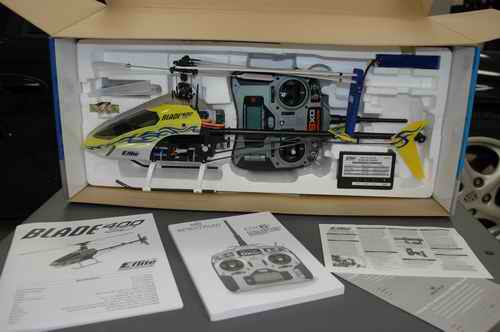
Flying The Blade 400
Features and specs are nice to know, but you can get those anywhere. What you really want to know is “how does it fly?” I was curious myself; but most importantly, I wanted to see for sure if this was a single rotor hobby grade RC helicopter I could recommend to newbies and experienced fliers alike... Absolutely without a doubt - YES!
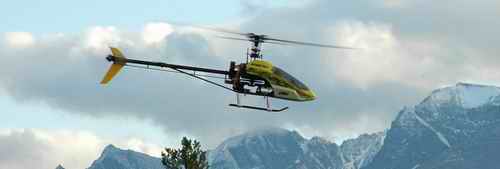
After several test flights, I came up with and programed in the perfect pitch and throttle curves to tame this agile little machine down into a great trainer. I also came up with some very nice dual rate values that further improve the trainer like settings. With the tamed down settings, the 1800 mAh battery was giving flight times of just over 11 minutes with scale type flying and going down to 3.2 volts per cell. This was the first big surprise seeing that the instructions indicate a 4-5 min flight time – obviously this is given on the 3D settings at full power.
When I got the kit, I also purchased an additional 11.1 volt 2100 mAh Thunder Power battery pack because I didn’t think the included 1800 mAh would produce a very long flight (according to what I had read). As you know, I think longer flight times are very important while you are learning.
The TP 2100 mAh pack is giving just over 14 minutes of scale type flying before the speed controller automatically starts cutting back power if you wish to push your LiPo down to 3 volts per cell - which is not recommended of course. Just make sure when you do get your extra battery pack, make sure or ask if it comes with EC3 connectors (the kind used in the Blade 400). If it doesn't, you will have to purchase a female EC3 connector and solder it to the power leads of the battery pack.
Here's the proceedure and video to solder an EC3 connector. Also make sure the balancing charge tap plug on the battery pack is compatible with the E-flite charger. If you are unsure of all this, just stick with E-flite 11.1 volt packs (either the 1800 mAh or the 2100 mAh) and you will be fine.
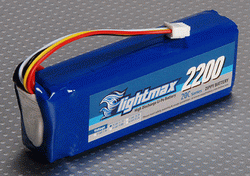 Another very good battery option I should mention if you want to save some serious coin are the Zippy FlightMax 3S 2200 mAh 20C packs. At only $11.99 you can purchase 4 or 5 for what a single name brand pack will cost.I have 5 of them now and can tell you they are much better than the stock E-flite packs (performance, capacity, balancing accuracy, and life span). They use the same JST-XH balancing plug as the E-flite pack uses, but you will have to solder on a EC3 power plug.
Another very good battery option I should mention if you want to save some serious coin are the Zippy FlightMax 3S 2200 mAh 20C packs. At only $11.99 you can purchase 4 or 5 for what a single name brand pack will cost.I have 5 of them now and can tell you they are much better than the stock E-flite packs (performance, capacity, balancing accuracy, and life span). They use the same JST-XH balancing plug as the E-flite pack uses, but you will have to solder on a EC3 power plug.Now that I had the perfect training set up, I thought I should see how the Blade 400 dealt with a set of Johnny’s home built training gear . This again was to see if I could recommend the Blade 400 as a superb first RC heli.
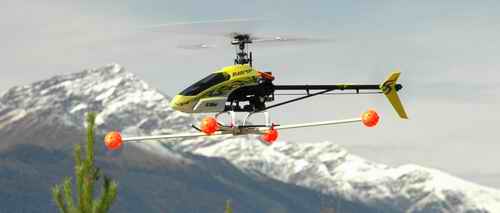
The 400 became even more stable once the additional weight of the training gear was added. I had expected it, but not to this extent. With the training gear on, my T&P curves, and dual rate settings I had entered, this little electric was starting to feel as stable and predictable as a much larger electric or nitro bird.
I really can’t get over how stable a 400 size can be with the right settings. Even with the added weight of the training gear on, the climb out rate is very impressive – better than most nitros I have flown with training gear on. You know what I was thinking – yup, this little bird will handle a scale fuselage no problem with the reserve power and flight times it was boasting.
Ok – how about sport flying. Take that training gear off, and switch to sport mode, time to start shaking a bit (me, not the heli).
I should start off by talking about the G110 gyro seeing that I have not mentioned it yet. This was the biggest unknown to me when I purchased the kit. I have flown with less than good gyros in the past and a gyro can make or break an otherwise good helicopter. I am glad to report the G110 is the decent match for the Blade 400.
The G110 is a full function heading hold gyro with remotely selectable gain and yaw rate modes.
The G100 is very locked in, even in substantial crosswinds. Fast pirouettes stopped on a dime with no tail wag – perfect gain settings from the factory.
The stock DS75 digital servo on the tail rotor works fine for general flying, but it is slow to react when you start pushing sport or light 3D flying. Aggressive climb-outs will cause noticeable heading deviation as the slower DS75 servo catches up and corrects for the heading change.
Upgrading to a faster tail specific tail servo makes such a huge improvement over the stock DS75. As I said, it is fine for when you are just learning, but to get the most out of the G110, you need a 0.06-0.08sec/60 degree fast digital tail servo out back.
The G110 gyro will exhibit a small amount of drift throughout the flight as it warms up or cools down; but again, for a low cost gyro that is boasting features once only seen in high end gyros, the performance is acceptable. I only had to give a few clicks of rudder trim at most to sort out any drifting that was occurring - certainly not up to the performance standards of an Align GP750 or Spartan DS760 gyro, but for the price - pretty good.
I was a little concerned how hard a smaller 400 size helicopter would be to see while flying large fast circuits. The high visibility yellow pod and tail fins really do a good job improving overall sight contact.

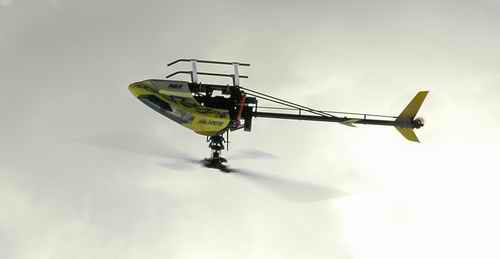 Loops and rolls are very predictable. With the light weight of the Blade 400, you don’t have to pull much if any negative pitch while going inverted if you have enough momentum. The climb out power is very impressive, and the heli exits the maneuver very predictably with no surprises. Once again I am no 3D guy. Loops, rolls, and pirouetting stall turns are pretty much as crazy as I want to get at my "older" age.
Loops and rolls are very predictable. With the light weight of the Blade 400, you don’t have to pull much if any negative pitch while going inverted if you have enough momentum. The climb out power is very impressive, and the heli exits the maneuver very predictably with no surprises. Once again I am no 3D guy. Loops, rolls, and pirouetting stall turns are pretty much as crazy as I want to get at my "older" age.This really boils down to a cost thing - a moderate crash on any of my other larger birds will easily set me back several hundred dollars. The blade 400 is now my "aerobatic practice bird" since parts are so inexpensive and easy to get .
It is hard to rack up a $50 dollar repair bill on the Blade in a moderate crash (assuming you don’t cake the LiPo battery in the process). Low replacement parts cost and availability is probably the single greatest attribute this little heli has going for it.
Like all 400 size helis, the Blade 400 gets a little tricky to fly when the wind picks up. The heli is so light, the translational lift changes bounce it around quite a bit. The added weight of training gear or a fuselage will certainly tame things down, but any sort of wind, especially a gusty wind when you are learning should be avoided at all costs.
What I Didn’t Like About The Blade 400
As good as this kit is there are a few minor issues I have with it.
First off, it is only available in a RTF (ready to fly) kit. There is no option of building it yourself (something I think is beneficial). I know this is market driven as almost every other "entry level" 400 bird out there are all pre-built and pre-flown. We live in an instant gratification society after all. I do however look at this in a new light since I got this RFT kit.
It was pretty nice being able to take this wonderful looking little heli out of the box, read the manual while the battery was charging and then go flying. Seeing that I keep saying I want people to succeed with RC helicopters, a RTF kit that has been flight tested does take much of the improper build and set-up problems associated with first time crashes out of the equation. For that reason, I do see real value in a RFT test flown kit now.
Second, the engineering and design team at E-Flite did a good job with the Blade 400 and all the components they packaged with it. However, in my opinion, the marketing team left some important info out.
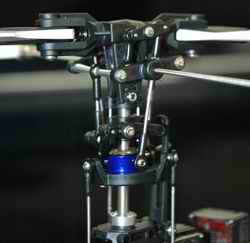 Many of the little important features in this bird are not mentioned. These include: Bell mixing, stainless steel push rods, stainless steel main rotor shaft, and the very good bearing count this heli has. Is this an oversight, or do most people not care about such things? I know I do... What about you?
Many of the little important features in this bird are not mentioned. These include: Bell mixing, stainless steel push rods, stainless steel main rotor shaft, and the very good bearing count this heli has. Is this an oversight, or do most people not care about such things? I know I do... What about you?The supplied tools, just like the tools in every other kit on the market are pretty poor in quality. The Allen drive keys are very soft and round out easily, as does the small Phillips screw driver. This is compounded by the fact that the thread locker used on some of the screws and set screws is very strong. Come on E-flite, STOP USING CA GLUE FOR THREAD LOCKER! If you don't have a good set of metric Allen drivers and a good quality small phillips screw dirver, you should really order some when you order your heli. The E-Flite set has the required sized allen drivers and phillips drivers. It is a good quality tool set at a great price. Definitely a "must get" tool as is a pitch gauge.
The instruction manual for the Blade 400 is not that great – this is a common problem with all kits these days however so I can’t really single out the Blade’s manual. It does a good job at explaining the operation of the heli and all the components but that is where it ends. Basically, manuals these days give you just enough information to be dangerous.
For example, why are there no recommendations for pitch and throttle curve values and dual rates for beginners? EVERYTHING about collective pitch helicopter success is in the setup - recommendations for beginner setup values as well as advanced settings are so important. 
0 comments:
Post a Comment